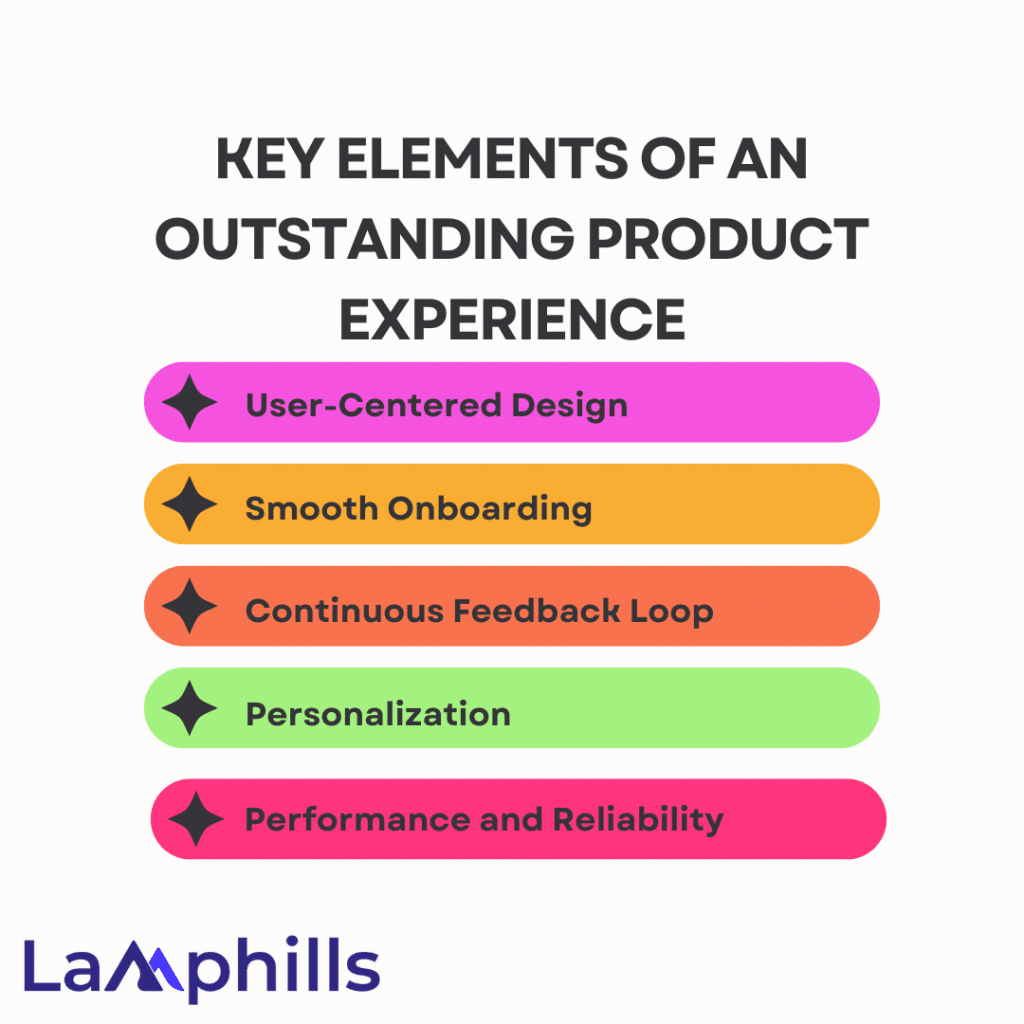When I initially got into digital marketing, the word “product experience” sounded both intriguing and intimidating. I vividly recall the long evenings, never-ending feedback loops, and numerous iterations. One example sticks out: a late-night user testing session revealed that our onboarding procedure was simply too complicated. Users were abandoning our product before they had even experienced its primary features. This discovery was a turning point. We updated our onboarding process to make it more intuitive and user-friendly. The results were astounding: user retention jumped by 30% nearly overnight. These experiences taught me that product experience is more than just functioning; it is about providing a seamless, engaging journey for the consumer. Here, we’ll show you everything you need to know about product experience so that your product not only meets but exceeds your customers’ expectations.
What is Product Experience?
Product experience refers to every encounter a consumer has with your product, from first discovery to frequent use and beyond. It’s about designing an intuitive, interesting, and enjoyable trip that will keep users coming back. According to a PwC survey, 73% of consumers consider experience to be an essential component in their purchasing decisions, second only to price and product quality. This statistic highlights how important product experience is in today’s competitive market.
Key Takeaways
- Product experience is critical for user retention and happiness, which influence purchasing decisions and brand loyalty.
- A superb product experience includes user-centered design, effortless onboarding, ongoing feedback, personalization, and performance optimization.
- Using tools and templates can help to streamline the product experience strategy, resulting in more efficiency and effectiveness.
How Do Product and User Experiences Differ?
While user experience (UX) focuses on specific encounters a user has with a product, PX considers the complete customer journey within the product. In many SaaS products, the entire customer journey from trial to purchase to renewal occurs within the product. Product teams must consider not only usability but also how the product can facilitate each stage of the journey and guarantee that customers receive ongoing value.
Why Is Product Experience Important?
Understanding the value of product experience is critical. It’s not enough to make a functional product; you also have to make one that people enjoy using. An excellent product experience can result in improved customer loyalty, higher conversion rates, and a better brand reputation.
SuperOffice discovered that 86% of buyers are willing to spend more for a better customer experience. This data alone demonstrates the potential return on investment from focusing on product experience.
Key Elements of an Outstanding Product Experience

#1. User-Centered Design
User-centered design means putting the user at the center of your product development process. This entails knowing their wants, behaviors, and pain areas using techniques such as user interviews, surveys, and usability testing. I used to skip user testing because of time restrictions. However, once I started incorporating customer feedback early and frequently, the improvements in user satisfaction were dramatic.
#2. Smooth Onboarding
First impressions are important, and a flawless onboarding process may make or break the user’s perception of your product. A well-designed onboarding experience enables users to quickly and effectively realize the value of your product. For example, when I improved our product’s onboarding sequence with interactive tutorials and tooltips, user engagement jumped by 30%.
#3. Continuous Feedback Loop
Engaging with users and gathering ongoing feedback is critical for iterating and enhancing your product. Implementing feedback tools like as in-app polls, feedback forms, and direct communication channels might yield useful results. According to UserTesting, organizations that consistently engage with their customers experience a 10% increase in customer loyalty.
#4. Personalization
Personalization makes the user experience more relevant and engaging. You can improve the user experience by using data to modify it. Netflix, for example, relies heavily on tailored recommendations, which contribute to their excellent customer retention rates. Personalization of my product resulted in a 25% boost in user retention.
#5. Performance and Reliability
A product that works effectively and is dependable provides a good user experience. Users anticipate quick loading speeds, minimal downtime, and a bug-free experience. According to Google, a one-second delay in mobile load times can affect mobile conversions by up to 20%. It is absolutely necessary to ensure that your product is performance-optimized.
How to Measure Your Product Experience
Now that you understand the value of product experience, it’s time to discover how to better understand and improve your customers’ product experiences. This is an initiative that will require the participation of the entire firm.
#1. Create a shared roadmap and promote a holistic approach
When you uncover modifications that need to be made, include them in a roadmap that is shared with the entire firm. In this manner, each department may contribute insights and comments to guarantee that the changes are implemented successfully.
#2. Define product experience KPIs
Next, you’ll need to develop a set of key performance indicators (KPIs) to assist you assess how clients are experiencing your product. This could include how frequently a specific function is utilized, how often people log in, and other behavioral indicators. A high churn rate or a poor net promoter score are clear indicators that something has to be fixed.
#3. Measure the customer experience to evaluate PX
The specific KPIs that must be tracked vary widely depending on the product, but the net promoter score is universal. NPS measures how likely a consumer is to promote your product, thus it’s the closest you can get to understanding how they perceive their experience with your product.
8 Tips for Improving the Product Experience
Knowing what your product experience is and bringing the entire organization on board is merely the beginning. Next, you must begin taking steps to improve your product experience.
Follow the eight steps below and utilize the KPIs you set in the previous section to track your progress toward your goals.
#1. Optimize user onboarding processes
Your experience with a product is heavily influenced by your ability to use it effectively. As a result, the first step should be to implement a thorough and exhaustive onboarding procedure.
#2. Gather and use customer input
We’ve discussed the net promoter score, which is an excellent approach to measuring customer satisfaction. You should also solicit additional input. Allow users to tell you what they like and dislike, and utilize this information to design future upgrades.
#3. Take analytics into consideration
Don’t forget the KPIs you set before. Are clients not adopting the new feature you added? Perhaps you should provide better instructions on the feature. Or perhaps awareness is the issue. Analytics is an excellent tool for identifying and addressing product experience issues.
#4. Educate on the value of your product
They say you don’t realize what you have until it’s gone. Customers might quickly become acclimated to your product and lose sight of what makes it unique. Even after you’ve made a sale, keep your value proposition fresh in the thoughts of your clients by continuing the conversation.
#5. Offer appropriate and consistent product information
This relates back to the issue that customers may be unaware of a new feature. Product information should be supplied quickly, properly, and comprehensively so that customers are never left in the dark about how to make the best use of the product. You want to make sure you are optimizing their experience.
#6. Prioritize and manage consumer problems
Resolving customer complaints swiftly not only improves the consumer’s product experience but also helps you enhance the experiences of anyone else who has comparable concerns but has not yet spoken up.
#7. Make the product experience important
Improving the product experience must become a key value for your firm and should be included in your retention strategy. If your clients do not have a positive experience with your product, they will go elsewhere.
#8. Scale your product
Just as you constantly adjust your ad text through A/B testing, you should also constantly refine your product based on user feedback and information gleaned from analytics and feedback. Products can and should be improved continuously.
Top Product Experience Tools To Increase Your User Engagement
Creating an excellent product experience demands more than just a great product; it also necessitates the proper tools to expedite the process, acquire insights, and optimize every user encounter. In this section, we’ll look at some of the most effective product experience solutions to help you improve user engagement and pleasure.
#1. User Research Tools
a. UserTesting
UserTesting is a tool for receiving real-time feedback from real users. It enables you to see how consumers engage with your product, providing vital insights into their behavior, preferences, and pain areas. Using these insights, you may make data-driven decisions to enhance your product experience.
Key features:
- Video records of user sessions.
- Detailed user feedback
- Customizable testing for specific user groups.
b. Hotjar
Hotjar combines analytics and feedback features to help you understand how visitors engage with your site. It provides a comprehensive user behavior perspective by including heatmaps, session records, and feedback surveys.
Key features:
- Heatmaps for visualizing user clicks and scrolling.
- Session recordings to see user interactions in real time.
- Feedback polls and surveys to collect user opinions.
#2. Onboarding and User Guidance Tools
a. Appcues
Appcues enables you to create unique onboarding experiences without having any coding knowledge. It enables you to create and deploy onboarding flows, tooltips, and user guides to walk users through your product’s features and functionality.
Key features:
- Drag-and-drop builder for developing onboarding experiences.
- Use in-app messages to guide users.
- User segmentation to provide individualized experiences
b. WalkMe
WalkMe is a digital adoption platform that offers on-screen coaching to help consumers traverse difficult software applications. It provides interactive tutorials and step-by-step walkthroughs to help with the onboarding process.
Key features:
- Interactive walkthroughs and tutorials.
- User analytics to monitor engagement and success
- Customizable assistance for various user segments
#3. Feedback and Survey Tools
a. SurveyMonkey
SurveyMonkey is a popular platform for creating and delivering surveys. It allows you to collect user feedback, identify their needs, and assess their satisfaction levels. This information can be quite useful for making educated judgments about product enhancements.
Key features:
- Customizable survey templates
- Advanced Analytics and Reporting
- Integration with additional tools, such as Salesforce and Mailchimp
b. Qualtrics
Qualtrics provides a comprehensive set of tools for conducting surveys and research. It has comprehensive functionality for generating, disseminating, and evaluating surveys to gain in-depth insights into user experiences.
Key features:
- Advanced survey design choices.
- Reliable data analysis and reporting
- Integration of CRM and marketing automation tools
#4. Personalization and Optimization Tools
a. Segment
Segment is a customer data platform that allows you to collect, clean, and manage your customer data. It helps you to personalize experiences by analyzing user behavior across several touchpoints.
Key features:
- Data integration from multiple sources.
- User segmentation to provide targeted experiences
- Real-time data synchronization with other technologies.
b. Optimizely
Optimizely is an experimentation platform that lets you run A/B tests and optimize product features depending on user behavior. It allows you to evaluate which variations of your product deliver the best user experience.
Key features:
- A/B and multivariate testing.
- Real-time analysis and reporting
- Personalized features for tailored user experiences.
#5. Performance Monitoring Tools
a. Google Analytics
Google Analytics is an effective tool for monitoring and analyzing website traffic. It delivers deep insights into user behavior, helping you to better understand how customers engage with your product and find areas for development.
Key features:
- Comprehensive traffic and user behavior analysis.
- Customizable dashboards and reports
- Integration with different Google products
b. New Relic
New Relic provides performance monitoring for your applications. It allows you to measure application performance, identify bottlenecks, and provide a pleasant user experience by maintaining ideal performance levels.
Key features:
- Real-time application monitoring.
- Detailed performance stats and statistics.
- Alerts and messages regarding performance difficulties
#6. Collaboration and Project Management Tools
a. Trello
Trello is a project management application that allows teams to collaborate on content creation while tracking project progress. Its graphic boards, lists, and cards help you organize and manage work.
Key features:
- Visual project boards and task lists.
- Collaborative aspects for team members
- Integration with additional technologies such as Slack and Google Drive
b. Asana
Asana is another popular project management application that allows teams to plan, organize, and track their work. It’s particularly handy for overseeing content creation initiatives and ensuring everyone is on track.
Key features:
- Task and project management.
- Team collaboration features
- Customizable workflows and templates
Templates for Improving Product Experience
Using the proper tools and templates will help you streamline your product experience approach. Here’s a template to help you create and implement a thorough product experience strategy.
You can use the Product Experience Strategy Template to streamline your efforts and ensure a thorough approach.
Conclusion
Creating an excellent product experience is a combination of art and science. Understanding your users, gathering feedback regularly, and being willing to iterate and improve are all necessary. Focusing on the essential factors outlined will ensure that your product not only meets but exceeds user expectations. Are you ready to improve your product experience and keep users coming back for more?
Related Articles
- Product Launch Press Release: How to Write With Examples
- Want Your Product to Fly Off the Shelves? Follow These 7 Branding Rules
- Rebuilding Trust After a Brand Mishap: 11 Expert Tips
- Reputation Recovery: How Experts Turn Negative PR into a Growth Opportunity
- HOW TO MEASURE BRAND REPUTATION IN 2024 (MY EXPERT TIPS)





